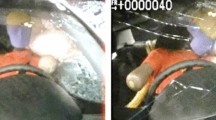Abstract
This paper provides an overview of the energy and crush-space required to provide survivable head-on impacts between motorcars and energy-absorbing poles. Additionally it was required that the poles be remaining upstanding and possibly serviceable after the crash. A simplified acceleration-displacement pulse for the combined car and pole was used in the modelling described here. This pulse was arrived at using results from full-scale tests and FEA simulations of impacts from 60 km/h. The depth of crush into the car, at the point when 20 g is reached was estimated using published analysis of full-scale tests and it is a function of the car's mass, width, length and the diameter of the pole. The division of crush depth between the pole and the car was calculated using the assumption that the pole can be developed to crush from the time that the car reaches 20 g acceleration. The results show that a pole that provides no more than 20 g acceleration to a light car and remain upstanding, will be demolished by a medium or heavier sedan. A pole that would likewise suit a medium sized car would provide very little acceleration reduction for the lightest cars, and the heaviest sedans would in turn demolish it. There appears to be no practical combination of pole size and stiffness that suits the whole range of sedans. If it were possible to identify a probable impacting type of car, then poles may be designed to provide significant hazard reduction for those cars, but they would be less effective to other cars.
Similar content being viewed by others
REFERENCES
Wood, D P, Doody, M and Moomey, S. “Application of a Generalised frontal Crush Model of the Car Population to Pole and Narrow Object Impacts”. SAE paper 930894, Society of Automotive Engineers, 1993.
Campbell, K L. “Energy Basis for Collision Severity”. SAE paper 740565, Society of Automotive Engineers, 1974.
Prasad, A K. “CRASH3 Damage Algorithm Reformulation for Front and Rear Collisions”. SAE paper 900098, Society of Automotive Engineers, 1990.
Smith, G C, James, M B, Perl, T R and Struble, D E. “Frontal Crush energy and Impulse Analysis of Narrow Objects Impacts”. Paper 87-WA/SAF-5 Presented at the Winter Annual Meeting ASME, Boston 1987.
Strother, C E, Wooley, R L, James, M B and Warner, C Y. “Crush Energy in Accident Reconstruction”, SAE paper 860387, Society of Automotive Engineers, 1986.
Saha, N K, Calso, S M, Prasad, P and Asjad, M U. “Simulation of Frontal Barrier Offset Impacts and Comparison of Intrusion and Decelerations”, SAE paper 950647, Society of Automotive Engineers, 1995.
Toyama, A, Hatano, K and Murakami, E. “Numerical Analysis of Vehicle Frontal Crash Phenomena”, SAE paper 920357, Society of Automotive Engineers, 1992.
LS-DYNA, Livermore Software Technology Corp, 2876 Waverley Way, Livermore, CA 94550.
Frontline System Inc. 1999. http://www.frontsys.com/.
Report 350. “Recommended Procedures for the Safety Evaluation of Highway features”, National Cooperative Research Program, Washington, D.C., 1993.
Rights and permissions
About this article
Cite this article
Lozzi, A., Briozzo, P. Energy absorbing stand-up roadside signposts. International Journal of Crashworthiness 8, 221–227 (2003). https://doi.org/10.1533/ijcr.2003.0225
Issue Date:
DOI: https://doi.org/10.1533/ijcr.2003.0225




